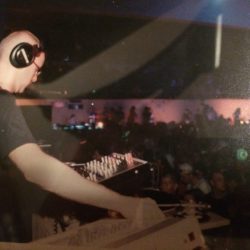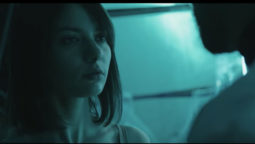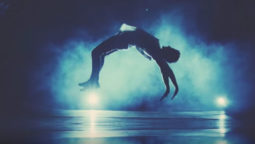As soon as the doors of the Denver Coliseum opened for Skylab XX on Saturday evening, it took no time at all for the party kids of Denver to fill up the venue. By the end of local house duo JQA’s opening slot on the Skylab Launch Pad stage, the fist-pumping, shuffling, glow stick-twirling crowd already extended to the back of the main floor while a line wrapping around the side of the colossal structure painted a lively swath of color against the sterile backdrop of the industrial cityscape.
By the time one of the event’s original organizers, DJ Fury, wrapped up his frenetic drum and bass set on the EDM.com Basspod stage, the venue reached capacity – affording Seven Lions the opportunity to play the infectious melodic dubstep anthems from the game-changing EP he released in April to an audience of 10,000. Eric Prydz followed with an hour and a half of intelligent and masterfully mixed tech house fit for a Global Underground mix, satisfying the discerning palates of the handful of dance music purists in attendance.

Tiësto during his set on the Skylab Launchpad Stage at Skylab XX. Photo by End of Light Photography.
When Tiësto took to the Launch Pad the main floor became a sea of densely packed bodies lit from above by what looked like celestial spheres, the crests of its waves rippling out from the stage every time he dropped another rattling big room anthem. As a promoter, that’s the “we did it” moment that you’ve been building towards for months, and the remainder of the ride requires little more than coasting to a stop at your destination.
Nobody complained that Tiësto’s set ran over a few minutes. Brad Roulier of Manufactured Superstars even came behind the DJ booth to hug him and exchange a few words of praise before he and Shawn Sabo geared up to start their closing set, donning their signature spacesuits. “You are listening to the Manufactured Superstars,” a distorted, monotone voice boomed over the speakers as they began to play. Owing to the hour the crowd thinned understandably, but many continued to dance with blissful smiles on their faces out of recognition for Roulier and Sabo’s role in the Denver club scene.
Anyone familiar with the local nightlife community knows that Roulier owns Beta Nightclub, the city’s premiere hub for major EDM headliners, and cofounded the recently SFX Entertainment-bought music download giant Beatport. However, Manufactured Superstars making the party’s lineup since their 2006 inception is only one facet of his involvement in the brand. In fact, even though Global Dance Festival and other Red Rocks events have taken center stage as premier dance music gatherings, in its 20-year history the annual Skylab event series has curiously linked all the people who have cornered the local market in more ways than most partygoers realize.
Whether you consider Colorado’s rave scene to be large or small is more a matter of vantage point than anything. If you compare it to those of any of its bordering states it’s certainly large, but it matches only a fraction of the activity in major markets like Las Vegas, L.A., New York City, Miami or Chicago. The deeper you dig into the history of dance music, the smaller the circle of key individuals shrinks – and in the microcosm of the Denver scene, it takes little effort to unearth the point in time at which everything came together.
Incidentally, the most sensible starting point for that story is the formation of Come Together Productions. As student of Colorado School of Mines, Jason Bills began to acquaint himself with the warehouse party scene around the end of the 80s when he caught a DJ set by John Chamié at a College party. “I loved the stuff he was playing and learned he played out at a few spots around town, mainly Rock Island,” Bills recalls. “Eventually a few small warehouse events started to pop up around Denver. The legendary Kitchen Club was the most memorable and regular.” Bills became a regular attendee, then even began making trips out to the West Coast for events like Funky Tekno Tribe and the Full Moon parties.

Front and back of the original flyer for Come Together, the first party Jason Bills threw under the name Come Together Productions.
Drawing on what he observed in Northern California as well as what was working for promoters in Denver, he kicked off Come Together Productions with a party of its namesake at the Gothic Theater in November of 1993. Characteristic of a simpler dance music era, the party’s three major headliners’ stage names all followed the “DJ first name” format (DJ Mort, DJ Carlos and DJ James, to be specific) and like other underground parties at the time, attendees were required to call an undisclosed phone number on the day of the event to receive its location.
As Come Together Productions gained traction in the local party scene, Bills came to collaborate with other promoters in the area. He, Steve Blakley (the aforementioned DJ Fury) of then-active production company Lowerworld, and Big Merrick of The Tribe began to toss back and forth ideas about an event centered around concepts akin to the live streaming that would become industry standard at raves over a decade later. Blakley, who originally became involved in the party scene while snowboarding professionally and driving all the way down from Summit County on the weekends, explains:
“Someone approached us about doing a party with a ‘live satellite link up’ between events all over the world. Keep in mind that this was way before the internet was capable of handling much, so the idea was really something special. [Come] Together [Productions], The Tribe, and myself all worked together to put the lineup together and we really pushed the live link up thing. Skylab wound up being one of the largest parties to date in Denver.”
Indeed, Skylab brought 1,700 pairs of feet through the door – and while that’s only about a sixth of the turnout of this year’s installment, it was about 1,000 more than what other warehouse parties at the time brought in. The out-of-state headliners included L.A.-based hardcore DJ Vitamin D, progressive house DJs Jeno and Garth from San Fransisco’s Wicked Crew (whom still spin back to back with eachother to this day), and techno/acid house legend Josh Wink from Philadelphia. The local lineup included Blakley himself (spinning hardcore jungle, the sub genre which more or less gave birth to drum and bass), L.L. Bishop, Nebula 9, Hipp-E and Craig C.
“Some of my best memories were what it was like to have a super diverse lineup on the main stage,” Bills says. “Everything from house to techno to drum and bass to hip-hop. As long as you were there for a good time, you were welcome!”
“The vibe was great back then, and the scene was small enough that you felt like a part of a community,” Blakley adds. “I know the smaller shows like that do exist still, but the big festival thing that’s going on right now is totally different. Still a better vibe, but with the pure numbers of people going out, I find it to be more of a concert feel.”
Skylabs 2, 3 and 4 furthered the brand and increased attendance by bringing out such renowned artists as Rabbit in the Moon, the Hardkiss Brothers, Laurent Garnier, DJ Dan and Global Communications. Nonetheless, throwing warehouse parties came came with its own set of often unforseen challenges. “When we started you basically had the same lighting you’d see at a Bar Mitzvah,” Blakley remarks. “I remember Skylab in 1994 being the first show to use ‘intelligent lighting,’ although no one knew how to program the lights at that point. The sound quality is dramatically different today, too. Just the transition away from turntables has made a huge difference. We used to have huge problems with jumping needles from all of the bass and people dancing. To be honest, I don’t miss that part.”
Technical difficulty aside, the risks associated with the early warehouse parties were a trying ordeal in and of themselves. “It was tough back then,” Blakley admits. “Trying to find a property owner to rent you a warehouse for one night while trying to make sure the cops were either ‘hired’ or unaware was no easy task.”
Furthermore, keeping an event under the mainstream radar often ran counter-intuitive to its bottom line. The tightrope walk of maintaining a low profile while putting out enough word of mouth advertisement that ticket sales covered expenses began to wear on Blakley. “I decided it was a good time to bow out of the game for a bit, so I sold Lowerword and my share of the events we all did [which included the Skylab parties as well as the Episode series] to [Come] Together Productions,” he says. Tired of ruining his credit, he bought the first Apple G3 computer and got ahold of graphic design software through some of his friends. “Since I was so involved in the scene, people started coming to me to do small jobs for them,” he explains. “That grew and grew organically.” 17 years later, Blakley now owns The Firm, a full-staff graphic design company whose clientele spans the globe – including companies like Insomniac, USC, V2 and Global Dance.
Even though Bills and Big Merrick sorely felt Blakley’s absence, his shoes were soon filled by a personality who would redefine their entire operation: Enter Brad Roulier.
“Brad and I met in March of 1997,” Bills says, “and we worked together on a national tour, followed by a return to Denver.” Brad originally became a minority partner in Come Together Productions, quickly moving up to full partner – and around the same time, the company shortened its name to the simpler “Together Productions.” “[Brad] was a little more business motivated than the rest of us back then,” speculates Blakley, “so his plan was to help Jason grow Come Together.” The first Skylab event that took place with Roulier as partner was Skylab 5 in 1998, which featured headlining sets by Kenny Ken, DB, Nigel Richards and several others. More importantly, Skylab 5 took place at an especially novel location: Bishop Castle.
Already a topic of controversy (and a thorn in the state government’s side) without facilitating an all-night dance party, Bishop Castle was a literal stone-set castle in a remote location outside Rye, Colorado built by a single man over several decades. Among throngs of attendees at Skylab 5 was Colorado-based DJ/producer/singer/songwriter/Vibe columnist Lea Luna, one of the few Denver artists talented enough to make a career out of music, who professes that the event was her first-ever rave at age 15. “I was fucked up out of my mind,” she admits.
Altered or otherwise, Luna remembers enough to put the disparity between the rave scene then and now in perspective. “The fashion was different, the venues were different, and the music was a lot more rudimentary because there was half the technology there is now,” she points out. “Also, DJs had a much more arduous job because [they] all had to actually use [their] ears and beat matching skills, haul [their] records, and pay for shipping and pressing of vinyl.
Luna also mentions incidents from the fifth edition whose infamy would only contribute to the Skylab legend. “Someone took some weird acid or something, stripped down naked, and climbed the side of the castle from what I heard,” she recounts. “Someone else sprayed pepper spray up inside the tower. It didn’t stop the party. I still had fun.”
Bills’ own high point from his time hosting the event series was Skylab 7 in 2000, where UK-based second-wave Detroit techno artist Richie Hawtin, British progressive house/ drum and bass sensation DJ Rap, and Miami bass legend DJ Craze were among the names on the bill. With Roulier’s help, he managed to expand Together Productions to the point where the outfit was organizing 8-10 events per year including the Skylab parties, the Episode series, the Flashback series, and Hallowfreak’nween (the latter of which also still takes place annually, and will feature Above & Beyond as the main headliner on the 31st of next month). Eventually, the two of them began promoting weeklies for The Church Nightclub and Club Vinyl, the flagship destinations under the SoCo Nightlife umbrella.
However, as new legislations placed additional pressures on rave promoters, the scale of risk versus reward began to once again tip in favor of the former. As if the adverse political climate didn’t complicate matters enough, an unexpected shift in the actual climate placed undue strain on Bills and Roulier’s operation. Bills elaborates:
“In March of 2003, we were managing all of the artist bookings and promoting events for The Church and Vinyl nightclubs. Our Vinyl nights accounted for about 70% of our company’s income. There was a massive blizzard and the weight of the snow caused Vinyl to collapse. At that moment or very shortly thereafter, I was out. All of the capital at that point was from our own pockets… I just couldn’t continue to keep my head up. We had amazing nights and made good money at one event, then had horrible nights and lost it all at the next. I had a wife and daughters and needed to make sure I took proper care of what mattered most. At the time – and now – it was my family.”
“Jason moved away in 2003,” Roulier says. “People change, priorities change,” he adds simply. Together Productions dissolved, and the 2003 installment of the Skylab series – which would have been its tenth anniversary – never took place. Soon after, Bills sought employment out of town with Mood Media, a company that provides marketing services centered around the customer experience to restaurants, bars, clubs and retailers. He still works for Mood Media, and is working towards the release of a social media platform geared towards the nightlife industry called “The Tract.”
Roulier didn’t waste any time feeling sorry for himself once the Together Productions era came to a close. In 2004 he cofounded Beatport, and in 2005 he formed an invaluable partnership in Ha Hau, the shrewd, soft-spoken mastermind behind Colorado dance music promotional powerhouse Triad Dragons.
In 2003 Triad Dragons had taken over control of Global Dance Festival, the aforementioned annual Red Rocks Amphitheater massive previously branded as “Rave on the Rocks” and then “Weekend of E” during the time that local radio station 93.3 KTCL organized it from 1999-2002. By 2005, the event had eclipsed Triad Dragons’ previous flagship event, Caffeine, rendering their fanbase a powerful asset.
“Ha from Triad [Dragons] would attend our events in 1999 to 2000,” Roulier explains. “I hired him as a promoter at the Church in 2005 … So we have worked together for many years.” Roulier and Hau’s next undertaking would garner attention from the older generation of dance music fans while simultaneously catering to the new ones; in the following year they set out to resurrect Skylab.
“The year Triad Dragons got involved was 2006,” Hau says, “and the rest is recent history.” Skylab 2006’s lineup featured progressive house staple John Digweed, Chicago house favorite Bad Boy Bill, and Seattle-based house prodigy Donald Glaude among others, and saw the return of DJ Dan, Vitamin D and Dieselboy as well. The main stage was the Beatport Stage, and stages billed the Flashback Stage, the Rewind Stage, and the Trance stage featured old house and techno, drum and bass, and trance artists, respectively.

Front and back of the original flyer for Skylab 2006, which was made by The Firm, Steve Blakley’s graphic design business.
The next four editions of Skylab incorporated on-the-rise talent that much of today’s contemporary EDM generation keeps in their collective queue. Household names like Armin Van Buuren, Morgan Page, BT, Ferry Corsten, Wolfgang Gartner and, of course, the Manufactured Superstars joined the ranks of Skylab headliners during that period as dance music made its gradual crawl back into the mainstream spotlight.
It was also during those years that Roulier purchased a property on the corner of Blake Street and 19th in the Lower Downtown District of Denver formerly called Rise and used it to open Beta Nightclub in 2008. Declared the #1 Nightclub in America in 2009 by DJ Mag for having the first Funktion One Dance Array system in the continent and the highest green rating of any club in the world, Beta quickly revolutionized the Denver dance music scene, Providing big-name DJs a further incentive to stop in the Mile High City.
By the dubstep breakthrough of 2010 that propelled dance music into popular culture, Roulier and his collaborators’ success ran parallel to the meteoric trajectory of the rest of the worldwide community. Beta, Global and Beatport had certainly grown into much bigger cash cows than the Skylab parties, but Skylab 2011 and 2012 would boast all-star lineups filled with such seminal names as Avicii, Fedde Le Grand, Zedd, Porter Robinson, Gareth Emery and Borgore. The EDM generation effectively rendered dance music the most sought-after commodity in the entertainment world, and Roulier and Hau reaped the benefits.
The entire scene doesn’t necessarily join Roulier and Hau to rejoice in dance music’s newfound popularity, though. A characteristic that sets the current musical movement apart from the last two is that it went on for 30 years before reaching the American mass media. In the wake of EDM becoming the new it-genre, a disparity grows between the old generation of dance music fans and the new ones in which the former perceives the latter as being disingenuously interested in it as a fad, and for making the party aspect of the scene a higher priority than the music and community. In addition, as the business side of it becomes more corporate the older fans fear being marginalized. In the case of Denver, for instance, Triad Dragons’ dubious partnership with promotional subsidiary AEG Live in 2012 and the sale of Beatport to SFX Entertainment in 2013 both caused an undercurrent of questioning murmurs that can still be heard in the local dance music community to this day.
The old and new fans clearly appreciate different qualities in music, too. “The artists of today’s events for the most part are more booked because of their production chops and not necessarily their ability to truly DJ,” Bills himself points out. “Not that there is anything wrong with that, it’s just different. The production skills today’s artists possess [are] insane and I completely understand how they are where they are. I’ll tell you what though – there is nothing like watching a skilled DJ on turntables build a set as he goes, customized to those on the dance floor.”
The newfound counterculture dynamic manifests in interesting ways. On the same day as Skylab XX, local promotional company The Hundred threw its own festival, the first annual Cloak & Dagger, across all the combined floor space of Club Vinyl (where Roulier used to promote), and City Hall. With deep/tropical/tech/progressive house artists like Cashmere Cat, Justin Martin, Moon Boots, Kidnap Kid and Holy Ghost on the lineup, the event sent a clear enough message: If you want an alternative to the teenyboppers, go to this. Attendees described it as “grown-ups dancing to grown-up music,” among other things, and as with other events put on by The Hundred it did attract a noticably older demographic.
But if tenured music lovers could leave their preconceptions at the door long enough to spend some time around the new generation, they might find that the two have more in common than they expect. Skylab XX attendee Josh Gold’s first rave was Skylab 2013, when Kaskade, Dillon Francis and Morgan Page topped the bill, and only two months ago he formed a group called Colorado EDM Family that organizes successful meetups at events among its already nearly 1,700 members. “My favorite thing is the relationships [the music] creates,” he says.
While some people get paid to do what Gold does and still don’t bring as many heads to a show (it’s not uncommon for over 100 group members to meet at each event), he has no official plans to try and monetize their gatherings. Furthermore, he welcomes everyone, only requiring adherence to a handful of guidelines set in place to ensure the group members’ safety. If and when he does decide to turn what he does into a business, it’s not a stretch to suggest that he or somebody like him could be the next Jason Bills. After all, Bills himself reiterates, “The number one aspect of the scene that attracted me then was, as I mentioned earlier, if you were there to enjoy yourself and had a positive attitude, you were welcomed with open arms. Race, gender, sexuality, etc. were thrown out the window.”

Brad Roulier and Shawn Sabo of Manufactured Superstars during their set on the Skylab Launchpad stage at Skylab XX. Photo by End of Light Photography.
Although the two friends haven’t worked together in a professional capacity for over a decade, Roulier echoes his sentiments. “It’s important to me to produce Skylab every year to give the younger people in Denver a party that keeps with the spirt of the events in the 90s,” Roulier says. “EDM evolves as Skylab had but at the root it is just a party with great DJs. Hopefully, the next Avicii or the next Fedde Le Grand is in the crowd being inspired by what they’re seeing.”
And about halfway through Manufactured Superstars’ set last Saturday, a phenomenon unfolded on the stage behind them that you don’t see at many headlining artists’ shows anymore. Where every other headliner only shared the stage with hired dancers – or with nobody in Tiësto’s case, as per his contract – members of the production staff began to spill onto the stage along with their friends, and probably even their friends’ friends. The lot of them started dancing as though the thousands still in attendance weren’t watching them front and center, as Roulier and Sabo mixed tracks both old and new.
After a while the lights came on, and the remaining attendees filed out as per venue staff instruction. As they stepped back out under the night sky they still felt the rattle of the bass, and despite having danced all night they weren’t yet compelled to slow down. The whole scene may have turned on its head in the 20 years that the Skylab parties have been going on, but somebody back in the old days felt the same feeling that they did at that very moment.














Join the discussion
comments powered by Disqus